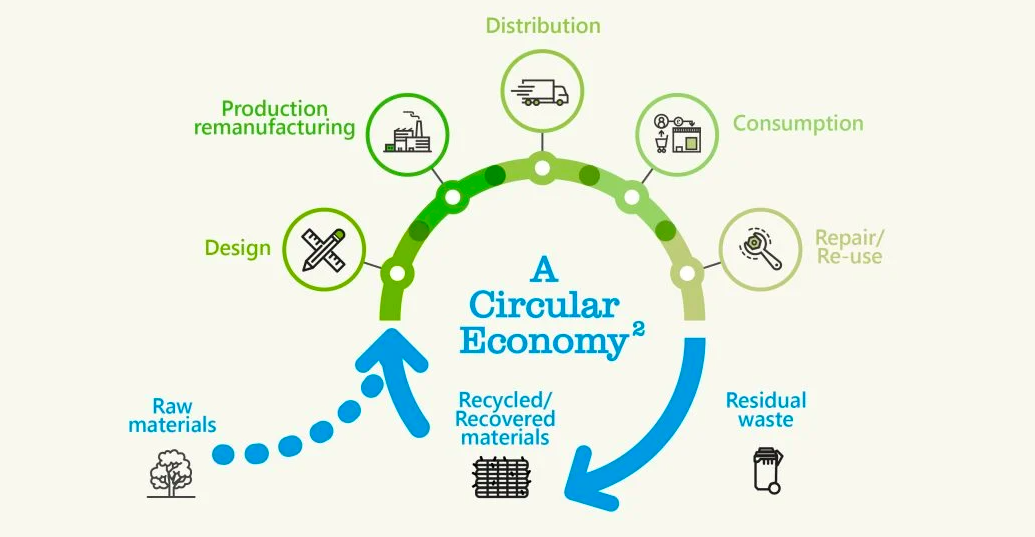The fashion industry is known for its fast-paced and ever-changing nature, constantly pushing out new trends and styles. However, this has come at a cost to the environment, with the industry being one of the largest polluters in the world.
According to research by Earth.org, of the 100 billion garments produced each year, 92 million tonnes end up in landfills. To put this in perspective, this means that the equivalent of a rubbish truck full of clothes ends up on landfill sites every second.
What is a Circular Economy?
The circular economy is an innovative solution that could help to address this issue and make the fashion industry more sustainable.
At its core, the circular economy is a model that seeks to keep resources in use for as long as possible, through recycling, reusing, and repurposing.
It entails markets that give incentives to reusing products, rather than scrapping them and then extracting new resources. In such an economy, all forms of waste, such as clothes, scrap metal and obsolete electronics, are returned to the economy or used more efficiently.
The traditional linear model of production, where materials are extracted, made into products, and then disposed of, is not sustainable in the long run.
The circular economy, on the other hand, aims to create a closed-loop system where materials are continuously reused, reducing the need for new resources to be extracted and reducing waste.

In fashion, the circular economy involves changing the way clothes are designed, produced, and consumed.
It means moving away from the fast fashion model, where clothes are produced quickly and cheaply, only to be worn a few times before being thrown away. Instead, it means creating durable, high-quality clothes that are made to last and can be repaired or repurposed when they eventually wear out.
One of the key ways to achieve a circular economy in fashion is by using sustainable materials.
This means using fabrics made from natural, renewable resources, such as organic cotton, linen, or hemp, as well as recycled materials, such as recycled polyester or nylon.
Using these materials, the fashion industry can reduce its reliance on non-renewable resources, such as petroleum-based fabrics like polyester or nylon, which can take hundreds of years to break down in landfills.
Another important aspect of the circular economy in fashion is the concept of closed-loop systems. This means that materials are kept in use for as long as possible, through recycling, repairing, and repurposing.
For example, old clothes can be recycled into new garments, or turned into rags or insulation. By keeping materials in use, the fashion industry can reduce the amount of waste that ends up in landfills and reduce the need for new resources to be extracted.
In addition to using sustainable materials and closed-loop systems, the circular economy in fashion also requires a shift in consumer behaviour.
Consumers need to become more conscious of the impact of their clothing choices and choose to buy clothes that are made sustainably and can be worn for a long time.
This means moving away from the fast fashion model and instead investing in quality, timeless pieces that can be worn season after season.
Finally, the circular economy in fashion also involves changing the way clothes are produced and sold. It means moving away from the traditional linear model of production, where clothes are produced in large quantities and sold at low prices, and instead moving towards a more decentralized, local model of production.
This means producing clothes in smaller quantities, closer to where they will be sold, reducing the need for long-distance shipping, and reducing the environmental impact of transportation.
Overall, the circular economy in fashion is an innovative and promising solution to the environmental challenges faced by the fashion industry.
By changing how clothes are designed, produced, and consumed, we can reduce our reliance on non-renewable resources, reduce waste, and create a more sustainable future for fashion.
While there is still much work to be done to fully implement a circular economy in fashion, there are already many examples of companies and designers who are leading the way and showing that sustainable, circular fashion is not only possible, but also desirable and profitable.
About the Author
Anne Marie McAuley is Programme Manager for Portobello Institute's BA (Hons) in Fashion Management and Fashion Buying & Merchandising.
Read her full profile here.
Find Out More
To find out more about our Business of Fashion courses visit our department page here.
If you are interested in any of our business of fashion courses or have any questions you can book a consultation call with our expert fashion advisor Sarah Coyne here email sarah.coyne@portobelloinstitute.com or call 01 892 0041.



-1.png?width=1200&name=Fashion%20(17)-1.png)

.png?width=352&name=Colms%20general%20article%20feature%20images%20(16).png)